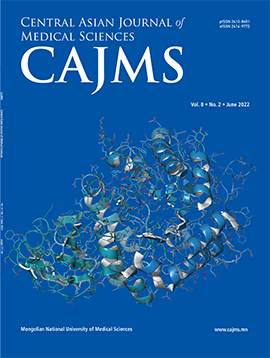Stroke from Prospective Acute Inpatient Rehabilitation Data: Functional Outcomes Using the Functional Independence Measure
DOI:
https://doi.org/10.24079/cajms.2020.06.005Keywords:
Functional Independence Measure, Rehabilitation, Ischemic and Hemorrhagic StrokeAbstract
Objectives: Stroke is a second leading cause of mortality and results often to severely lasting disability in worldwide. We studied the long-term effects of rehabilitation after stroke as a key factor in improving the quality of life, due to the reason that Mongolia has one of highest rates of ischemic heart disease. The aim of this study was to evaluate functional outcomes of all patients admitted to an inpatient rehabilitation unit in a tertiary hospital using Functional Independence Measure (FIM), and analyze factors that are associated significantly with progression of discharge functional scores and higher functional gains. Methods: In this longitudinal study over a two-month period, functional data for 104 patients admitted consecutively to the Stroke Center at Third State Central Hospital inpatient rehabilitation unit in Mongolia were charted into a custom designed rehabilitation database. The primary outcome measures were the discharge total FIM scores, FIM gain and FIM efficiency. Multiple linear regression analysis were used to identify independent variables associated with better discharge FIM scores and FIM gain. Results: The mean age was 56.3 ±11.6 years and 55.7% of the patients were male. Ischemic stroke (28.8%) followed by hemorrhagic stroke (71.2%) were more common diagnoses. The average rehabilitation length of stay was 9.3 ± 2.2 days. The mean admission total FIM score was 42.3 ± 20.7 and the mean discharge total FIM score was 61.3 ± 24.6, with this gain being highly significant (P < 0.001). The mean FIM gain was 18.6 ± 17.4 and FIM efficiency was 2.1 ± 1.0 points per day. Factors associated with better functional outcomes were higher admission motor and cognitive FIM scores, male gender and a longer rehabilitation length of stay. Conclusions: The FIM is an easy-to-use, standardized and robust general measure of functional disability. The total FIM scores of all patients, participated in this study, significantly improved. Moreover, longer rehabilitation LOS resulted in a negative effect on discharge FIM scores. To our knowledge, this study is the first study that examines the stroke rehabilitation using FIM scores as the primary outcome measure in Mongolia.
Downloads
277
Downloads
Published
How to Cite
Issue
Section
License
Copyright (c) 2020 Mongolian National University of Medical Sciences

This work is licensed under a Creative Commons Attribution-NonCommercial 4.0 International License.




